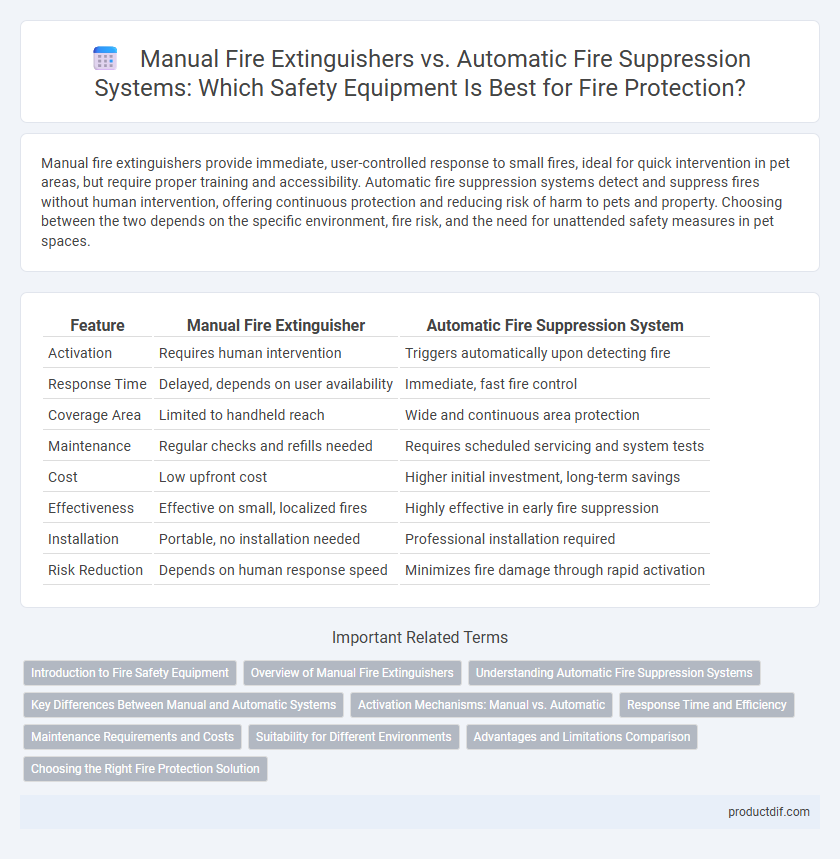Manual fire extinguishers provide immediate, user-controlled response to small fires, ideal for quick intervention in pet areas, but require proper training and accessibility. Automatic fire suppression systems detect and suppress fires without human intervention, offering continuous protection and reducing risk of harm to pets and property. Choosing between the two depends on the specific environment, fire risk, and the need for unattended safety measures in pet spaces.
Table of Comparison
| Feature | Manual Fire Extinguisher | Automatic Fire Suppression System |
|---|---|---|
| Activation | Requires human intervention | Triggers automatically upon detecting fire |
| Response Time | Delayed, depends on user availability | Immediate, fast fire control |
| Coverage Area | Limited to handheld reach | Wide and continuous area protection |
| Maintenance | Regular checks and refills needed | Requires scheduled servicing and system tests |
| Cost | Low upfront cost | Higher initial investment, long-term savings |
| Effectiveness | Effective on small, localized fires | Highly effective in early fire suppression |
| Installation | Portable, no installation needed | Professional installation required |
| Risk Reduction | Depends on human response speed | Minimizes fire damage through rapid activation |
Introduction to Fire Safety Equipment
Manual fire extinguishers provide a portable, user-operated solution for immediate fire response, ideal for small-scale fires in homes and businesses. Automatic fire suppression systems detect and suppress fires without human intervention, offering continuous protection in high-risk environments like commercial kitchens and industrial facilities. Both types of equipment are essential components of a comprehensive fire safety strategy, ensuring rapid response and minimizing property damage and injury.
Overview of Manual Fire Extinguishers
Manual fire extinguishers are portable devices designed for immediate use in small fires, relying on human operation to identify and suppress flames. They come in various types such as water, foam, CO2, and dry chemical, each suited for different fire classes like A, B, C, and electrical fires. These extinguishers are essential safety equipment in homes, offices, and vehicles, providing a first line of defense before automatic fire suppression systems engage or emergency responders arrive.
Understanding Automatic Fire Suppression Systems
Automatic fire suppression systems detect and respond to fires without human intervention by releasing extinguishing agents such as water, foam, or chemical powders. These systems are equipped with sensors that trigger activation upon detecting smoke, heat, or flames, ensuring rapid and continuous fire control, which significantly reduces property damage and risk to occupants. Unlike manual fire extinguishers, automatic systems provide consistent protection in high-risk environments where immediate response is critical.
Key Differences Between Manual and Automatic Systems
Manual fire extinguishers require human intervention to operate, relying on users to identify and respond to fires promptly, making them ideal for small, localized fire incidents. Automatic fire suppression systems detect fires through sensors and activate suppression agents without human involvement, offering continuous protection and faster response times for larger or high-risk areas. The key difference lies in the activation method and response speed, with automatic systems enhancing safety through immediate and autonomous fire control capabilities.
Activation Mechanisms: Manual vs. Automatic
Manual fire extinguishers require human intervention for activation, relying on quick and accurate user response to effectively combat fires. In contrast, automatic fire suppression systems utilize sensors and detection technology to initiate fire suppression without human involvement, ensuring rapid and consistent activation. This distinction in activation mechanisms directly impacts response time and effectiveness in emergency fire scenarios.
Response Time and Efficiency
Manual fire extinguishers rely on human intervention, resulting in slower response times and potentially higher risk during fire emergencies. Automatic fire suppression systems detect and activate instantly, minimizing fire spread and increasing overall efficiency in hazard containment. Studies show that automatic systems can reduce fire damage by up to 80% compared to manual methods.
Maintenance Requirements and Costs
Manual fire extinguishers require regular inspections, refilling, and occasional replacements, leading to moderate maintenance costs that are manageable for most facilities. Automatic fire suppression systems demand comprehensive upkeep, including periodic testing, system diagnostics, and component servicing, resulting in higher maintenance expenses due to their complexity. Choosing between the two depends on balancing upfront installation costs against ongoing maintenance commitments and budget constraints in fire safety management.
Suitability for Different Environments
Manual fire extinguishers are ideal for small-scale fires in residential, office, and vehicle environments where immediate human intervention is feasible. Automatic fire suppression systems suit industrial, commercial kitchens, and high-risk areas requiring continuous monitoring and instantaneous activation without manual input. Selecting the appropriate system depends on the environment's fire risk level, accessibility, and the presence of trained personnel.
Advantages and Limitations Comparison
Manual fire extinguishers offer quick response and portability, allowing users to target specific small fires immediately, but rely heavily on user presence and correct operation. Automatic fire suppression systems provide continuous protection and rapid activation without human intervention, effectively controlling fires in critical areas, yet involve higher installation costs and potential maintenance complexity. Choosing between these options depends on the specific environment, risk factors, and required level of fire safety automation.
Choosing the Right Fire Protection Solution
Selecting the appropriate fire protection solution depends on factors such as the environment, potential fire risks, and response time requirements. Manual fire extinguishers provide immediate, user-operated intervention, ideal for small, accessible areas or trained personnel, while automatic fire suppression systems offer continuous, automated detection and extinguishing, crucial for high-risk or unattended locations. Evaluating occupancy type, fire hazard classification, and maintenance capabilities ensures optimal safety and compliance with fire protection standards.
manual fire extinguisher vs automatic fire suppression system Infographic

 productdif.com
productdif.com